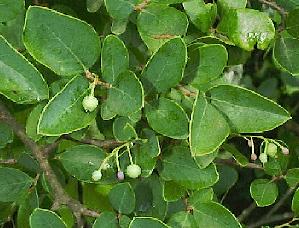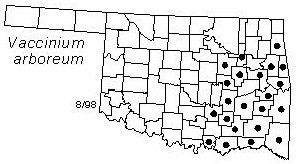
Shrub or small tree to 8 m (25 ft) tall. Crown irregular. Bark gray-brown to gray. Twigs light brown, dark brown or gray, glabrous or puberulous. Leaves alternate, simple, evergreen to semipersistent; oval, obovate, or elliptic, 2.5-7.5 cm (1-3 in) long and about 2.5 cm (1 in) wide; leathery, glabrous, paler in color beneath; cuneate at base, acute or rounded at apex, margins entire or somewhat dentate; petioles short. Flowers in axillary racemes about 1.3 cm (0.5 in) long; flowers urceolate (bell-shaped), 5-toothed; petals 5, white-pink; styles 1; stamens 10; flowers appear from May to June. Fruits globose berries about 8 mm (0.3 in) in diameter, black, with many seeds; fruits mature August to December.
Distribution: Texas and Oklahoma, east to Virginia, south to Florida, west to Louisiana. Common in eastern Oklahoma.
Habitat: rocky slopes and woodlands.
NWI status: FACU.
Comments: Vaccinium is the classical name for blueberries; arboreum refers to its tree-like appearance.
Field identification: The latest flowering blueberry. Fruits are rather tasteless.
Wildlife benefits: Fruits are eaten by numerous bird species.
Medicinal uses: A root bark extract is used to treat diarrhea.
Economic uses: Farkleberry bark is used for leather tanning and the wood for making tool handles.
Distribution in Oklahoma: 
BACK
NEXT
RETURN TO INDEX
Last update: 9/22/99
 Go to Oklahoma Biological Survey Home Page
Go to Oklahoma Biological Survey Home Page
 Disclaimer
Disclaimer